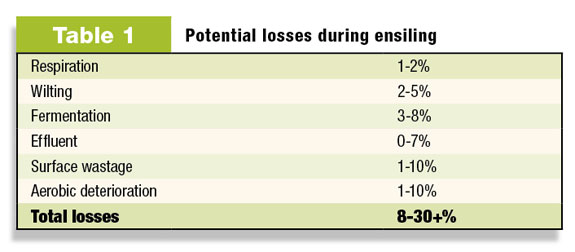The question is, are you looking at tons in the field or tons in the silage pile, and have you allowed for dry matter losses?
It is easy to assume that if you harvest 300 tons of a crop for silage at 33 to 34 percent dry matter, you will have 100 tons dry matter of silage to feed.
In reality you never will, because of the dry matter losses which occur between cutting and consumption by the cows.
These usually range from 15 to 25 percent, so you would be left with 75 to 85 tons of dry matter to feed in the above example.

So what are these dry matter losses, and what can be done to reduce them? Table 1 shows the range of losses usually seen in silage.
Respiration losses occur from cutting until air has been removed from the pile or used up. During this phase, sugars are broken down to carbon dioxide and water, heat is produced and energy and dry matter are lost.
Minimizing time from cutting to ensiling and doing a good job of packing and sealing the pile will reduce respiration losses.
Fermentation losses occur once the pile is sealed and fermentation has started. These losses can vary considerably depending on the bacterial population in the crop and the buffering capacity (resistance to a drop in pH) of the crop.
This affects how quickly the pH drops. Corn silage has a low buffering capacity, and grass and high-protein crops have a high buffering capacity.
This is one of the areas where a proven silage inoculant can help. Silage inoculant applies large numbers of efficient lactic acid bacteria to swiftly convert sugars into lactic acid with minimum losses.
It will also minimize protein breakdown so there is more true protein preserved in the silage for animals to convert into milk or live weight gain.
Effluent losses are usually low to negligible in silages with a dry matter content over 30 percent, but can be an issue with wetter silages.
Wilting losses are not an issue for corn, as it is directly cut, but can be high for crops left out in the field for days.
Surface wastage, usually seen on the top and shoulders of a pile, can certainly result in losses, some of which are quite visible.
Good compaction, right to the last load, and good sealing will reduce these losses. Tires should be touching all the way across the pile and dirt/sand can be used around edges to reduce the flow of air under the plastic.
Aerobic deterioration is one of the major causes of dry matter losses in corn and cereal silage especially. It occurs once the pile has been opened up and the face is exposed to air.
Bacteria and yeasts, which thrive in the presence of oxygen, start consuming soluble sugars in the silage. The pH rises, the silage starts to heat and nutrients are lost.
Planning the pile size and shape so that the face moves back at least six to 12 inches a day during feedout will help minimize aerobic deterioration.
Applying a good silage inoculant will also help to reduce aerobic breakdown, by improving the stability of the silage and its resistance to an increase in pH when exposed to air.
Keep the face smooth and tight to keep surface area and air penetration to a minimum. Only remove plastic needed daily, as too much plastic removed will expose silage to air longer. Put the silage out as close as possible to when the cows are going to eat it.
Overall, fermentation and surface wastage losses are a concern for all silages. Wilting, effluent losses, and aerobic deterioration are also major areas of dry matter loss.
If you want to be feeding out 85 tons dry matter for every 100 tons dry matter you cut, rather than 75 tons, then focus on pile design, packing and sealing and face management during feedout.
When wilting silage, wilt rapidly to minimize losses in the field. Remember to make sure you are using a high-quality silage inoculant, which has been proven to reduce losses. FG
Caley Heiman is a Territory Sales Manager with Alltech.









